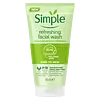The Derma Co 2% Cica-Glow Daily Face Wash Versus Simple Skincare Kind To Skin Refreshing Facial Wash
What's inside
What's inside
 Key Ingredients
Key Ingredients

 Benefits
Benefits

 Concerns
Concerns

 Ingredients Side-by-side
Ingredients Side-by-side

Water
Skin ConditioningSodium Lauroyl Sarcosinate
CleansingAcrylates Copolymer
Cocamidopropyl Betaine
CleansingAloe Barbadensis Leaf Juice
Skin ConditioningCentella Asiatica Extract
CleansingDecyl Glucoside
CleansingSodium Cocoyl Apple Amino Acids
Skin ConditioningXylitylglucoside
HumectantAnhydroxylitol
HumectantXylitol
HumectantGlycolic Acid
BufferingTranexamic Acid
AstringentGlycyrrhiza Glabra Root Extract
BleachingTocopheryl Acetate
AntioxidantMethylchloroisothiazolinone
PreservativeMethylisothiazolinone
PreservativeSodium Hydroxide
BufferingWater, Sodium Lauroyl Sarcosinate, Acrylates Copolymer, Cocamidopropyl Betaine, Aloe Barbadensis Leaf Juice, Centella Asiatica Extract, Decyl Glucoside, Sodium Cocoyl Apple Amino Acids, Xylitylglucoside, Anhydroxylitol, Xylitol, Glycolic Acid, Tranexamic Acid, Glycyrrhiza Glabra Root Extract, Tocopheryl Acetate, Methylchloroisothiazolinone, Methylisothiazolinone, Sodium Hydroxide
 Reviews
Reviews

Ingredients Explained
These ingredients are found in both products.
Ingredients higher up in an ingredient list are typically present in a larger amount.
Cocamidopropyl Betaine is a fatty acid created by mixing similar compounds in coconut oil and dimethylaminopropylamine, a compound with two amino groups.
This ingredient is a surfactant and cleanser. It helps gather the dirt, pollutants, and other impurities in your skin to be washed away. It also helps thicken a product and make the texture more creamy.
Being created from coconut oil means Cocamidopropyl Betaine is hydrating for the skin.
While Cocamidopropyl Betaine was believed to be an allergen, a study from 2012 disproved this. It found two compounds in unpure Cocamidopropyl Betaine to be the irritants: aminoamide and 3-dimethylaminopropylamine. High-grade and pure Cocamidopropyl Betaine did not induce allergic reactions during this study.
Learn more about Cocamidopropyl BetaineSodium Hydroxide is also known as lye or caustic soda. It is used to adjust the pH of products; many ingredients require a specific pH to be effective.
In small amounts, sodium hydroxide is considered safe to use. However, large amounts may cause chemical burns due to its high alkaline.
Your skin has a natural pH and acid mantle. This acid mantle helps prevent harmful bacteria from breaking through. The acid mantle also helps keep your skin hydrated.
"Alkaline" refers to a high pH level. A low pH level would be considered acidic.
Learn more about Sodium HydroxideTocopheryl Acetate is AKA Vitamin E. It is an antioxidant and protects your skin from free radicals. Free radicals damage the skin by breaking down collagen.
One study found using Tocopheryl Acetate with Vitamin C decreased the number of sunburned cells.
Tocopheryl Acetate is commonly found in both skincare and dietary supplements.
Learn more about Tocopheryl AcetateWater. It's the most common cosmetic ingredient of all. You'll usually see it at the top of ingredient lists, meaning that it makes up the largest part of the product.
So why is it so popular? Water most often acts as a solvent - this means that it helps dissolve other ingredients into the formulation.
You'll also recognize water as that liquid we all need to stay alive. If you see this, drink a glass of water. Stay hydrated!
Learn more about Water